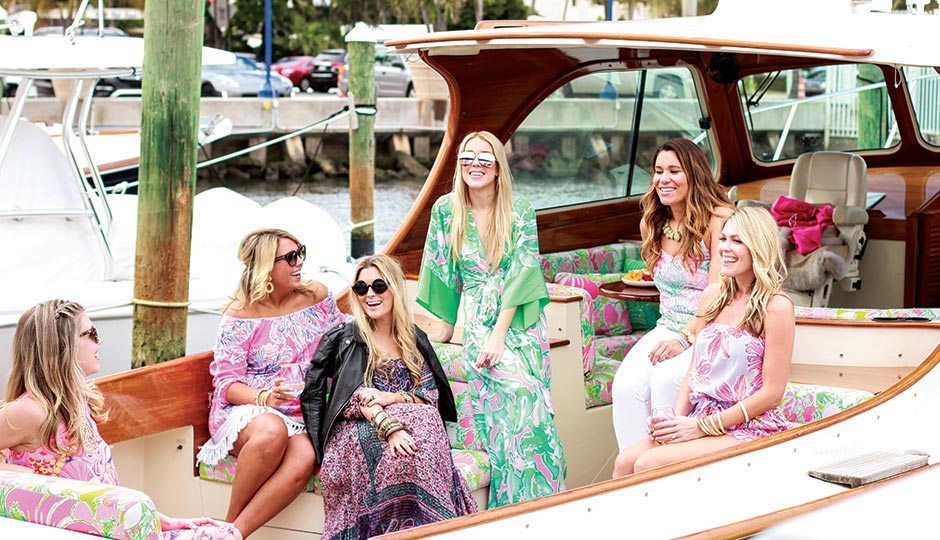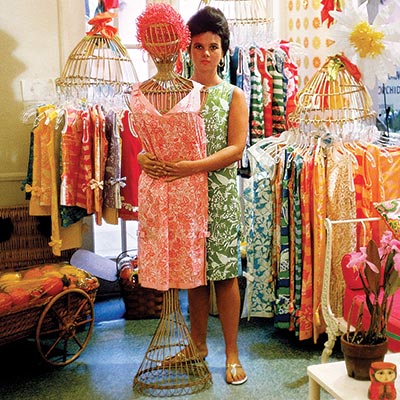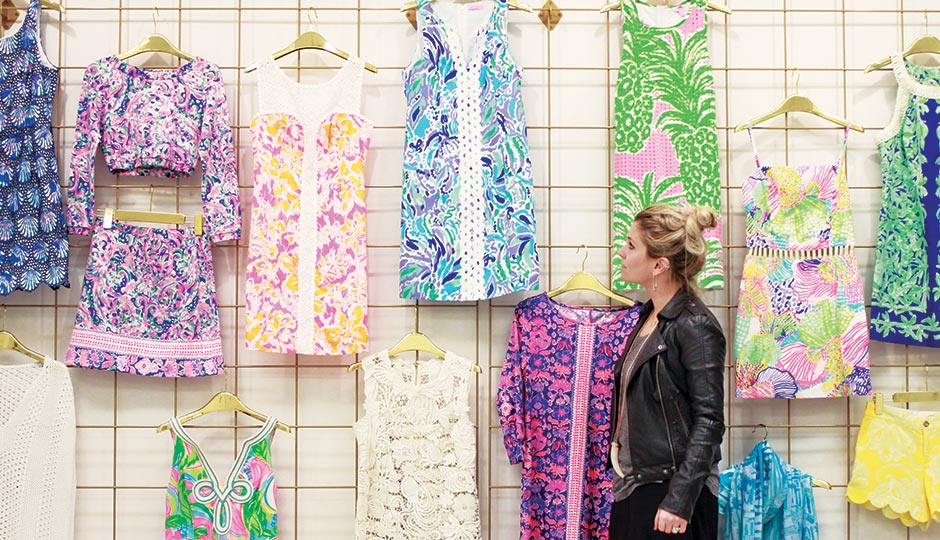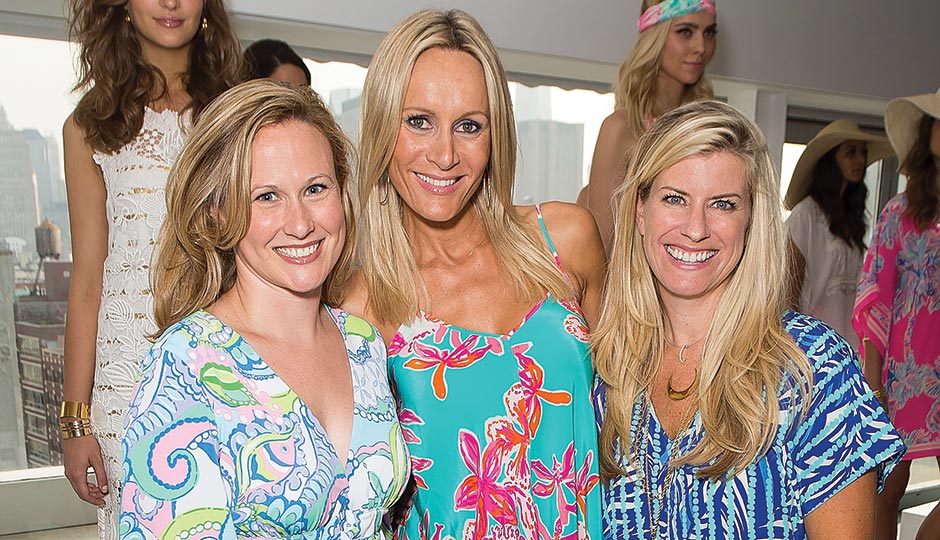Inside Lillyland: This Is Why Women Are Obsessed With Lilly Pulitzer

The author in a sea of Lilly. Photograph by Adam Jones
IT’S NOT PARTICULARLY WARM on the Lilly Pulitzer yacht, especially once we’re out in the middle of the Intracoastal Waterway in Palm Beach, but the style blogger in the purple-and-pink romper doesn’t care. Or at least she doesn’t show it if she does. She’s a professional, and when it’s time to film a quick video for Lilly Pulitzer’s Snapchat account, she perches on the side of the boat that has the best view of the palm trees and waterside mansions, tosses her blond hair — once, twice, the wind rippling through it too roughly for her liking — and then, on cue, throws her tawny, Twizzler-thin arms in the air and lets out a screeching “WOOOOOOOOOO!!!”
This sort of shriek has been the rallying cry of our trip — semi-staged squeals that call attention to the group (although how could you not notice a giggly cloud of highlighter-bright prints, champagne flutes soaring for constant toasts, our boat the only one in the marina upholstered in splashy pink-and-green florals?) and let more than two million Lilly Pulitzer fans across Snapchat, Instagram, Facebook and Twitter know that we are having more fun than you.
It’s these fans I’m looking to understand, the diehards who camp outside an expo center in Oaks for the brand’s annual warehouse sale, who rushed the doors of a million Targets (and almost instantly crashed its website) last spring when Lilly launched an exclusive collaboration with the discount retailer, who create Instagram accounts and Facebook groups to discuss the company’s every move. I’ve previously dismissed these women as Main Line country clubbers, Southern debutantes, sorority sisters — sweet, but with an edge of mean girl — yet these women are formidable, armed with a ferocious loyalty that has catapulted this once-dead company into a $200-million-a-year megabrand. Lilly Pulitzer has inspired a new sort of superfandom, one that’s age-spanning and bizarrely protective. It’s an enviable group to have on your side, the dream consumer base of every company. So the multi(multi) million-dollar question is: How did this preppy, beach-obsessed fashion brand from the ’60s — headquartered in King of Prussia, of all places — manage to swing it?
It’s precisely this question I’m thinking about as I crowd in for another Snapchat video, obligingly raising my champagne flute and joining in another “WOOO!!!” I’m wondering if those fans will notice that I’m the only one not wearing Lilly Pulitzer (of course they will — I’m in a black leather jacket); if they can see that my nails are inky black oil slicks in a sea of bubblegum-pink manis; and if they would tear me limb from limb if they knew the truth:
I secretly hate Lilly Pulitzer.
“READY TO HEAD to paradise!?”
This is the first sentence of the trip itinerary the Lilly team emailed me a few weeks ago. “Paradise” is Palm Beach, Florida, a tony sanctuary for monied grandparents and also the pink-and-green belly of the Lilly Pulitzer beast. I’m here for three days with two members of the Lilly team, both from Philly: Eleni McCready, the company’s social media director, and Caroline Wright, a social media senior associate. My assistant editor is here, too, gamely trailing us around and snapping photos in a way that sort of makes me feel like Kim Kardashian.

The author, center, on her Lilly cruise. Photograph by Lauren McGrath
The itinerary is designed to give me a sense of the “Lilly Perspective”: a bike ride around the island, a walk-through of the Lilly design studio, a boat ride with local “influencers.” The trip is planned with military precision, and Eleni and Caroline deftly navigate any hiccups (i.e., my persistent lateness for dinner, and the constant threat of rain, which seems, at its core, against brand). Lilly Pulitzer is practiced at this junket thing; it’s sort of their shtick, flying press to their inspiration playground, wining and dining them until even the most jaded editor dreams of living among the fabulous tight-faced grannies and preppy socialites. So I find myself here, ready to infiltrate the cult of Lilly Pulitzer, to suss out exactly who these worshippers are, to see if I can understand them, and — perhaps most importantly — to find out if I can be converted to the bright side.
It’s not that other people haven’t tried to convert me. My mother, who’s four-foot-eleven and approximately the size of a blade of grass, wears a rainbow uniform of Lilly each summer. She met Lilly Pulitzer once, brunching with her at Lilly’s Palm Beach estate — a spousal perk on one of my dad’s business trips. When I sleep at my parents’ Shore house, I wake up to a picture of Lilly on the nightstand, her arm draped around my mother. But I fear it’s my mom’s slight stature that allows her to wear pink octopi and green pineapples without looking like an imbecile. If I tried this, I’d look like a couch cushion. Or just a couch.
Back in my hotel room, I tick off the items in my suitcase: an army green military button-up, a pair of Rick Owens-esque black drop-crotch pants, and, thank God, a handful of vintage caftans, the only spots of color in the bunch. It’s not that I’m against color, but in the dead of a Philadelphia winter, I gravitate toward dark, swooping layers. It seems natural in Philly, which, as I write this, is blanketed in a dank, dirty slush. But next to Eleni and Caroline — both walking Lilly prints — I feel like a sullen, angsty teenager.
“Around here, ‘fall’ is the f-word,” Eleni says gleefully. I make a note to not ever curse in a Lilly store, because my f-word is quite different. And she’s not joking: Visit a Lilly Pulitzer store in the bowels of December and you’ll find pastel bikinis, pink tunics, palm-printed shorts. It’s very nice in theory — who doesn’t want to dress like you’re on vacation all the time? — but it also seems a tad unrealistic, especially when you’re confronted with pesky things like the blizzards and below-freezing temperatures of the Northeast.
Lilly’s farfetched dreamland isn’t a product of head-in-the-sand oblivion, but rather savvy aspirational marketing and a bit of smoke and mirrors. The brand is rooted in history, but it has brilliantly leveraged technology to cultivate its fan base. (Caroline coined the idea of an interactive “Snapchat party” back in 2013; the company was the first fashion brand to create custom geofilters, which overlay a user’s Snapchats with Lilly prints.) The devotion can’t totally be measured by numbers — they haven’t yet reached the coveted million mark on Instagram — but their engagement rates, or the number of times someone interacts with content, are higher than those of brands with triple the following. That’s because nothing here feels like a calculated move in the grand chess game of social media, but instead seems natural, friendly, happy. Genius.
Folks, the future of social media marketing is here. And it’s wearing a hot pink dress with lobsters on it.
TO UNDERSTAND THE SOCIAL ASPECT of the company, you have to understand its history. It’s a story all Lilly loyalists know, and they recite it with biblical reverence.
“You know the history of the juice stand, right?” says superfan Annie Fairfax over the phone. (I first sent her a direct message via Instagram; her handle, @LillyLovingPrep, has more than 15,500 followers, which is impressive considering that she’s a 22-year-old college senior from a tiny Michigan town. She wrote me back within minutes, bubbling over to discuss her favorite topic.)
The Lilly Pulitzer crash course: Free-spirited socialite and oil heiress Lilly McKim elopes with Peter Pulitzer, grandson of newspaper magnate Joseph Pulitzer, in 1952 and moves to Palm Beach, blowing into town like a breath of fresh air. She’s an exotically bohemian type, a bronzed brunette who plays tennis barefoot, hosts riotous parties, and walks down Worth Avenue with her pet rhesus monkey on her shoulder. But soon she grows restless, in the way that only the bottomlessly wealthy do. So she opens a juice stand with her friend, former Harper’s Bazaar fashion editor Laura Robbins Clark — an oft-forgotten character in the romanticized Lilly legend, the Steve Wozniak to Lilly’s Steve Jobs.

Pulitzer in her flagship shop circa 1962. Photograph from “Essentially Lilly: A Guide to Colorful Entertaining”
The two find that their clothes are becoming stained with juice spills; Lilly asks her seamstress to create a colorful dress to camouflage the stains — one that’s sturdy, with slits at the sides, and lined. (Lilly eschews underwear, just as she eschews shoes.) The pair begin selling these dresses — two styles, both electric in color and pattern — at the juice stand for $22. The Palm Beach crowd goes wild, and when Lilly’s former classmate Jackie Kennedy (now a First Lady) is featured in Life magazine wearing Lilly in 1962, so does the rest of America. After decades of prim resort wear, it was time to loosen up. Enter Lilly’s shifts, a literal shift in culture.
“This was the ’60s,” explains Eleni. “It was the youth movement. It was color television. Life became bright.”
She’s retelling the now-mythical story to me in the Palm Beach design studio, where we’re surrounded by mood boards and not-yet-released spring prints. I feel out of place in my black moto jacket and studded boots, and silently apologize to Lilly diehards for being awarded this precious glimpse of the mother ship and probably not appreciating it hard enough. But Caroline and Eleni are gracious, bursting to relay Lilly’s story to me, leapfrogging over one another with anecdotes — “Do you want to tell the next part or should I?”
Their breathless excitement is contagious. I giggle with them, marveling over the watercolor prints that lie among paintbrushes and artists’ palettes — each pattern is created by in-house artists; even the colors are custom — spellbound at the way this design team hides the word “Lilly” within the patterns, the fashion version of Where’s Waldo. (“The designers will say, ‘The Lilly needs to be harder to find — we need a chicken print, throw in some more critters,’” Caroline says in her lilting Southern drawl.) Things here are glossy and cheery and happy and uncomplicated.
Oh my God, I realize. I’m starting to love this place.
EVEN THE BRIGHTEST THINGS eventually dull, though, and by the ’80s, Technicolor flower power had been sidelined by beige Working Girl bravado, all shoulder pads and Liz Claiborne. Donna Karan started her eponymous company in 1984, the same year Lilly Pulitzer filed for Chapter 11 bankruptcy.
“Lilly always said, when she woke up one day and didn’t feel like she was just ready to leap out of bed, it was over. So she closed up shop,” says Eleni. (If fall is the f-word, then I guess bankruptcy must be the b-word: No one at Lilly mentions the particulars of this part of the story to me, the same way Laura is conspicuously left out of their narrations; a onetime secretary and treasurer of the company, she sold her stake to Lilly in ’69, but the two remained dear friends until Lilly’s death in 2013.)
So the fashion world got a little less bright, with cabanas turning over to cubicles and shift dresses swapped for skirt suits. But the demand for Lilly never completely faded, especially in wealthy pockets of the East Coast, and in 1993, on the cusp of the expiration of the Lilly Pulitzer trademark, a pair of Harvard MBAs living on the Main Line bought the rights to the company and brought it back from the dead. (A proper resurrection story, Lilly our modern-day Jesus in a shrimp-print caftan.)
Their names were James Bradbeer Jr. and Scott Beaumont, appropriately preppy guys who were steeped in the history of the brand, which by this time had evolved from its boho counterculture beginnings to become the essential regalia of Waspy blue bloods. They set up shop in Bradbeer’s house but by 2003 were entrenched in a 100,000-square-foot office building — now home to about 200 employees — located just behind the King of Prussia mall. It’s called the Pink Palace; its stucco exterior is the color of a seashell, and its interior is jarringly sunny. I visit it on a Monday late-afternoon, the city still wet and dreary as it shrugs off the last of winter. I curse myself for forgetting to wear color. Again.
In the Pink Palace, typical workplace trappings are offset by palm trees, wicker furniture, blazing pink walls, and a soaring central atrium that’s designed to look like Palm Beach’s iconic vias, with butter-yellow stucco facades, Spanish-style red-tile awnings and, of course, a juice stand. They play upbeat music here all day long. It’s like a boring office building on spring break.

The author tours the company’s Palm Beach outpost. Photograph by Lauren McGrath
“It’s really what you would expect from looking at any of our dresses,” says Michelle Kelly. Another Harvard MBA, she’s the powerhouse who, as of just a few weeks ago, officially took over for Beaumont and Bradbeer as CEO of Lilly Pulitzer. “At first glance, it’s this happy, whimsical, colorful garment. Then you look a bit closer and you realize how well-made it is, how well it fits, how happy you feel in it. There are a lot of parallels to our office culture, because at first glance, it seems like we’re having a lot of fun and going on boats, spending time in Palm Beach.” I nod emphatically at this part, telepathically letting her know that, yes, it does seem like a lot of fun and also I maybe could be easily persuaded to work there. “And then you realize that there is some science here. There’s a real intensity, a fast pace to the business. We will have very strategic conversations about … elephants.”
The Lilly Pulitzer office culture has been a buzzy topic ever since New York magazine’s The Cut visited the Pink Palace last May for a photo slideshow of the headquarters. A close-up shot of an employee’s cubicle wall revealed two cartoonish drawings of overweight women, with heartbreaking captions: “Put it down, carb face” and “Just another day of Fat, White and Hideous.” The Internet freaked out. At last! Photographic proof that Lilly Pulitzer was elitist, a cabal of fat-shaming mean girls.
It was also sticky timing. The month before, Lilly had launched its Target line, which was equal parts runaway success story (the 250-piece collection sold out within minutes — Lilly Pulitzer’s own daughter missed out — and reinvigorated the public’s awareness of and fondness for the brand) and PR failure, in that it exposed the dark side of snooty Lilly fans, who tweeted things like: “Sorry but @LillyPulitzer should not be sold at Target. Sucks if you can’t afford it but that’s life” and “If you weren’t classy enough to have it before, you sure as hell aren’t classy enough now” and, my favorite, “Lilly and Jackie are crying tonight in heaven at the thought of #LillyforTarget. It was never supposed to be this way.”
The backlash was curious; after all, Target’s collaborations with high-fashion brands like Jason Wu, Proenza Schouler and Rodarte hadn’t sparked such outrage. Adweek chalked it up to the class divisions between “old” and “new” money: “Target may have partnered with high-end brands in the past, but Lilly Pulitzer is the first old-guard, social-register brand to sign on, and that makes a big difference.” Eleni chalks it up to a misunderstanding of the company’s fundamental ethos; Lilly herself was nothing if not inclusive. I chalked it up to bitchy sorority girls, which was exactly what I was expecting when I talked to Annie Fairfax, the collegiate superfan.
Annie has popular Instagram and Tumblr accounts, and a YouTube channel where she posts “haul” videos in which she details her Lilly purchases and gives fit, style and fabric reviews. There’s also her Lilly fan group on Facebook, now up to more than 5,000 members. (“I have about 400 pending requests, but I’ve been trying to keep it small,” she says.) It’s a close-knit community that shares styling suggestions and facilitates clothing swaps, especially for kids’ pieces. They speak in Lilly pattern names. Annie loves Lilly, the color pink, mermaids and all things preppy. I want to hate her.
And I love her. She’s a freaking delight.
“A lot of people see Lilly as a status symbol, but I don’t think that’s it at all,” she says over the phone. “For me, it’s nostalgic of my hometown and fun summer times in Michigan. If you’re going to wear one of these dresses, you’re going somewhere fun.”
Bingo. Annie has stumbled on the driving force behind the modern-day Lilly Pulitzer success, the secret sauce I went to Palm Beach to find, the pink Kool-Aid that everyone seems to be drinking. And it’s simple — laughably, deceptively simple: fun.
“It boils down to an emotional connection,” says Lilly’s senior vice president of marketing and communications, Janie Paradis (pronounced, unbelievably, like “paradise”). “You remember the dress you got engaged in, or when you were on spring break. So many women come in because they’re packing and they want the best in resort wear. And then it just feeds that cycle — they wear it with their boyfriend on a long weekend and have the time of their lives, and then they remember the pieces.”

Lilly executives, from left: Michelle Kelly, Mira Fain and Janie Paradis. Photograph by Michael Stewart/Getty Images
It’s brilliant to capitalize on our emotional connection to the things we wear, and to focus on only the clothing that — nine times out of 10 — women will have on during happy times. (It doesn’t hurt that the clothes conjure images of a Southampton-bound Jackie, the Lilly fan’s reigning style queen.) And it’s working: In 2015, Lilly’s revenue increased 22 percent. Since 2013, sales have grown by almost 50 percent.
“We decided we wanted to be the best for a slice of her closet when she’s going away or if she’s living in warmer climates, rather than just okay at 12 months of the year. Being serene with that focus gave us so much freedom,” says Janie of the company’s fairly recent allegiance to its new first commandment, Resort 365. Or, in other, very un-Lilly-like words: F*** fall.
A FEW WEEKS LATER, I’m back in Philly, on the 36th floor of a gray Center City high-rise. It’s a far cry from the boat, the manicured hedges of Palm Beach, the weirdly tropical Pink Palace in the middle of a King of Prussia office park. I realize that I’m in black, again, and vow to start wearing some more color. I glance over at my bulletin board, where I tack up magazine tears, articles and artwork that inspire me. Now I have two hand-painted Lilly patterns hanging there, gifts from Eleni, pinpricks of color that remind me of Florida.
I’m sitting at my desk like I always do: legs scissored beneath me, shoes scattered somewhere, barefoot. I think of Lilly, walking barefoot down Worth Avenue. How fabulous would it be, I think, if I had a monkey?
“So, did you drink the Kool-Aid?” my editor asked me when I got back from Florida. No, I assured him. Absolutely not.
Then, a text from Caroline, with a link: “Look who made the Palm Beach Daily News!” I click it, and there’s a story about my boat ride with the style bloggers. I scan the photos accompanying the piece, sure that I’ll look out of place, a dark blemish amongst the bright, preppy blondes. And then I see myself, seated next to Caroline in a row of Lilly superfans. My head is thrown back, and I’m laughing wildly, hair blowing in the wind, completely caught up in the moment. Before I realized they’d done it, they’d done it: Like champagne or palm trees, a Lilly shift now telegraphs to me vacation, freedom, happiness. You know — fun. It’s almost scary. I look back at the photo. My black leather jacket is off — I don’t remember taking it off; it was cold — and I can almost hear it:
WOOOOOOOOOOOO!!!
For more behind-the-scenes photos from the trip, click here.
